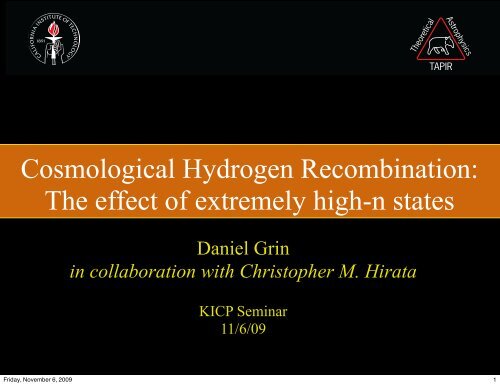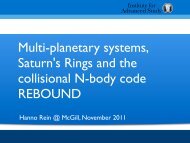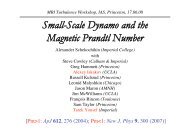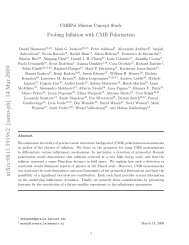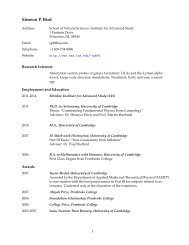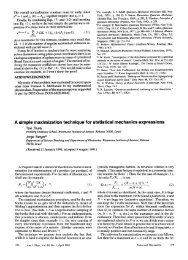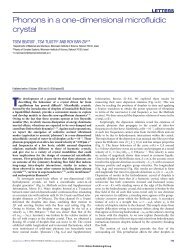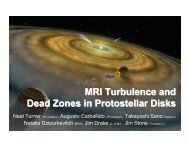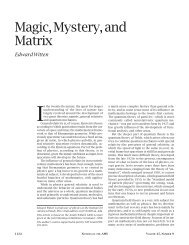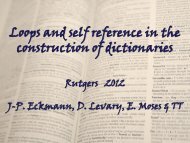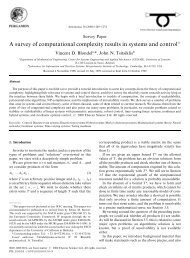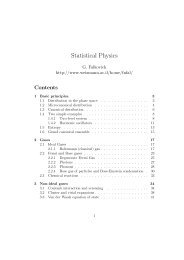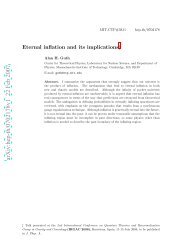Cosmological Hydrogen Recombination: The effect of extremely ...
Cosmological Hydrogen Recombination: The effect of extremely ...
Cosmological Hydrogen Recombination: The effect of extremely ...
You also want an ePaper? Increase the reach of your titles
YUMPU automatically turns print PDFs into web optimized ePapers that Google loves.
<strong>Cosmological</strong> <strong>Hydrogen</strong> <strong>Recombination</strong>:<br />
<strong>The</strong> <strong>effect</strong> <strong>of</strong> <strong>extremely</strong> high-n states<br />
Daniel Grin<br />
in collaboration with Christopher M. Hirata<br />
KICP Seminar<br />
11/6/09<br />
1<br />
Friday, November 6, 2009<br />
1
OUTLINE<br />
✴ Motivation: CMB anisotropies and recombination spectra<br />
✴ <strong>Recombination</strong> in a nutshell<br />
✴ Breaking the Peebles/RecFAST mold<br />
✴ RecSparse: a new tool for high-n states<br />
✴ Forbidden transitions<br />
✴ Results<br />
✴ Ongoing/future work<br />
2<br />
Friday, November 6, 2009<br />
2
WALK THE PLANCK<br />
✴ Planck (launched May 2009) will make cosmic-variance limited CMB<br />
anisotropy measurements up to l~2500 (T), and l~1500 (E)<br />
✴ Wong 2007 and Lewis 2006 show that<br />
parts in 10 4 accuracy for Planck data analysis<br />
Friday, November 6, 2009<br />
needs to be predicted to several<br />
3<br />
3
RECOMBINATION, INFLATION, AND REIONIZATION<br />
✴ Planck uncertainty forecasts using MCMC<br />
0.93 0.94 0.95 0.96 0.97 0.98<br />
n s<br />
2.98 3 3.02 3.04 3.06<br />
log[10 10 A s<br />
]<br />
0.022 0.0225 0.023<br />
0.08 0.09 0.1 0.11<br />
✴<br />
✴<br />
<strong>Cosmological</strong> parameter inferences will be <strong>of</strong>f if recombination is improperly modeled<br />
(Wong/Moss/Scott 2007)<br />
Leverage on new physics comes from high l. Here the details <strong>of</strong> recombination matter!<br />
✴ Inferences about inflation will be wrong if recombination is improperly modeled<br />
CAVEAT EMPTOR:<br />
Need to do eV physics right to infer anything about 10 15 GeV physics!<br />
Friday, November 6, 2009<br />
4<br />
4
RECOMBINATION, INFLATION, AND REIONIZATION<br />
✴ Planck uncertainty forecasts using MCMC<br />
0.93 0.94 0.95 0.96 0.97 0.98<br />
n s<br />
2.98 3 3.02 3.04 3.06<br />
log[10 10 A s<br />
]<br />
0.022 0.0225 0.023<br />
0.08 0.09 0.1 0.11<br />
✴<br />
✴<br />
<strong>Cosmological</strong> parameter inferences will be <strong>of</strong>f if recombination is improperly modeled<br />
(Wong/Moss/Scott 2007)<br />
Leverage Bad on recombination new physics comes history from yields high biased l. Here the inferences details <strong>of</strong> about recombination reionization matter!<br />
✴ Inferences about inflation will be wrong if recombination is improperly modeled<br />
CAVEAT EMPTOR:<br />
Need to do eV physics right to infer anything about 10 15 GeV physics!<br />
Friday, November 6, 2009<br />
4<br />
4
WHO CARES?<br />
SMEARING AND MOVING THE SURFACE OF LAST SCATTERING<br />
(SLS)<br />
✴ Photons kin. decouple when Thompson scattering freezes out<br />
γ + e − ⇔ γ + e −<br />
✴ Acoustic mode evolution influenced by visibility function<br />
g =˙τe −τ 5<br />
✴<br />
z dec ≃ 1100<br />
: Decoupling occurs during recombination<br />
5<br />
Friday, November 6, 2009
WHO CARES?<br />
THE SILK DAMPING TAIL<br />
N=#/! C<br />
l damp ∼ 1000<br />
! D "N 1/2 ! C<br />
✴ Inhomogeneities are damped for λ
WHO CARES?<br />
CMB POLARIZATION<br />
From Wayne Hu’s website<br />
✴ Need time to develop a quadrapole<br />
Θ l (kη) ∼ kη<br />
2τ Θ l (kη) ≪ Θ l (η) if l ≥ 2, in tight coupling regime<br />
✴ Need to scatter quadrapole to polarize CMB<br />
7<br />
Friday, November 6, 2009<br />
7
WHO CARES?<br />
CMB POLARIZATION<br />
From Wayne Hu’s website<br />
✴ Need time to develop a quadrapole<br />
Θ l (kη) ∼ kη<br />
2τ Θ l (kη) ≪ Θ l (η) if l ≥ 2, in tight coupling regime<br />
✴ Need to scatter quadrapole to polarize CMB<br />
7<br />
Friday, November 6, 2009<br />
7
WHO CARES?<br />
CMB POLARIZATION<br />
From Wayne Hu’s website<br />
✴ Need time to develop a quadrapole<br />
Θ l (kη) ∼ kη<br />
2τ Θ l (kη) ≪ Θ l (η) if l ≥ 2, in tight coupling regime<br />
✴ Need to scatter quadrapole to polarize CMB<br />
7<br />
Friday, November 6, 2009<br />
7
WHO CARES?<br />
SPECTRAL DISTORTIONS FROM RECOMBINATION<br />
Friday, November 6, 2009<br />
8<br />
8
SAHA EQUILIBRIUM IS INADEQUATE<br />
p + e − ↔ H (n) + γ (nc)<br />
✴ Chemical equilibrium does reasonably well<br />
predicting “moment <strong>of</strong> recombination”<br />
x 2 e<br />
1 − x e<br />
=<br />
( 13.6<br />
T eV<br />
) 3/2<br />
e 35.9−13.6/T eV<br />
x e =0.5 when T = T rec ≃ 0.3 eV<br />
z rec ≃ 1300<br />
✴Further evolution falls prey to reaction freeze-out<br />
Γ
BOTTLENECKS/ESCAPE ROUTES<br />
BOTTLENECKS<br />
✴ Ground state recombinations are in<strong>effect</strong>ive<br />
τ −1<br />
c→1s = 10−1 s −1 ≫ H ≃ 10 −12 s −1 10<br />
✴Resonance photons are re-captured, e.g. Lyman<br />
α<br />
ESCAPE ROUTES (e.g. n=2)<br />
✴ Two-photon processes<br />
✴ Redshifting <strong>of</strong>f resonance<br />
Friday, November 6, 2009<br />
10
THE PEEBLES PUNCHLINE<br />
✴ Only n=2 bottlenecks are treated<br />
✴Net Rate is suppressed by bottleneck vs. escape factor<br />
− dx e<br />
dt = S ∑<br />
n,l>1s<br />
α nl (T ) { nx 2 e − x 1s B(T ) } 11<br />
11<br />
Friday, November 6, 2009
THE PEEBLES PUNCHLINE<br />
✴ Only n=2 bottlenecks are treated<br />
✴Net Rate is suppressed by bottleneck vs. escape factor<br />
− dx e<br />
dt = S ∑<br />
n,l>1s<br />
α nl (T ) { nx 2 e − x 1s B(T ) } 11<br />
11<br />
Friday, November 6, 2009
THE PEEBLES MODEL<br />
✴Net Rate is suppressed by bottleneck vs. escape factor<br />
12<br />
Friday, November 6, 2009<br />
12
THE PEEBLES MODEL<br />
✴Net Rate is suppressed by bottleneck vs. escape factor<br />
Redshifting term<br />
12<br />
Friday, November 6, 2009<br />
12
THE PEEBLES MODEL<br />
✴Net Rate is suppressed by bottleneck vs. escape factor<br />
12<br />
Friday, November 6, 2009<br />
12
THE PEEBLES MODEL<br />
✴Net Rate is suppressed by bottleneck vs. escape factor<br />
Ionization Term<br />
12<br />
Friday, November 6, 2009<br />
12
THE PEEBLES MODEL<br />
✴Net Rate is suppressed by bottleneck vs. escape factor<br />
Ionization Term<br />
redshift term<br />
2γ term ≃ 0.02 Ω 1/2<br />
m<br />
(<br />
(1 − x e [z])<br />
1+z<br />
1100<br />
) 3/2<br />
Ω m<br />
12<br />
2γ process dominates until late times (z 850)<br />
Friday, November 6, 2009<br />
12
THE PEEBLES MODEL<br />
✴ Peebles 1967: State <strong>of</strong> the Art for 30 years!<br />
Ω m h 2<br />
Ω b h 2<br />
13<br />
Friday, November 6, 2009<br />
13
EQUILIBRIUM ASSUMPTIONS<br />
✴Radiative/collisional eq. between different l<br />
✴ Radiative eq. between different n-states<br />
N n = ∑ l<br />
N nl = N 2 e −(E n−E 2 )/T<br />
✴Matter in eq. with radiation due to Thompson scattering<br />
T m = T γ since σ TaT 4 γ c<br />
m e c 2
EQUILIBRIUM ASSUMPTIONS<br />
✴Radiative/collisional eq. between different l<br />
Seager/Scott/Sasselov 2000/RECFAST!<br />
✴ Radiative eq. between different n-states<br />
N n = ∑ l<br />
N nl = N 2 e −(E n−E 2 )/T<br />
Non-eq rate equations<br />
✴Matter in eq. with radiation due to Thompson scattering<br />
T m = T γ since σ TaT 4 γ c<br />
m e c 2
BREAKING EQUILIBRIUM<br />
✴ Chluba et al. (2005,6) follow l, n separately, get to n max = 100<br />
✴ 0.1 %-level corrections to CMB anisotropies at n max = 100<br />
✴ Equilibrium between l states:<br />
bottleneck<br />
✴ Beyond this, testing convergence with<br />
n max<br />
is hard!<br />
How to proceed if we want 0.01% accuracy in x e (z) ?<br />
15<br />
Friday, November 6, 2009<br />
15
THESE ARE REAL STATES<br />
✴ Still inside plasma shielding length for n
THE EFFECT OF RESOLVING L- SUBSTATES<br />
7<br />
Resolved l vs unresolved l<br />
l<br />
n max<br />
= 100<br />
6<br />
5<br />
ΔN e<br />
/ N e<br />
in %<br />
4<br />
3<br />
2<br />
1<br />
0<br />
200 400 600 800 1000<br />
z<br />
1200 1400 1600<br />
✴ ‘Bottlenecked’ l-substates decay slowly to 1s: <strong>Recombination</strong> is slower; Chluba al. 2006<br />
17<br />
Friday, November 6, 2009<br />
17
RECSPARSE AND THE MULTI-LEVEL ATOM<br />
✴<br />
✴<br />
✴<br />
We implement a multi-level atom computation in a new code, RecSparse!<br />
Bound-bound rates evaluated using Gordon (1929) formula and verified using WKB<br />
Bound-free rates tabulated and integrated at each<br />
✴ Boltzmann eq. solved for 18<br />
Friday, November 6, 2009<br />
18
THE MULTI-LEVEL ATOM (MLA)<br />
✴ Two photon transitions between n=1 and n=2 are included:<br />
✴ Net recombination rate:<br />
19<br />
Friday, November 6, 2009<br />
19
THE MULTI-LEVEL ATOM (MLA)<br />
✴ Two photon transitions between n=1 and n=2 are included:<br />
✴ Net recombination rate:<br />
2s-1s decay rate<br />
19<br />
Friday, November 6, 2009<br />
19
THE MULTI-LEVEL ATOM (MLA)<br />
✴ Two photon transitions between n=1 and n=2 are included:<br />
✴ Net recombination rate:<br />
Einstein coeff.<br />
19<br />
Friday, November 6, 2009<br />
19
THE MULTI-LEVEL ATOM (MLA)<br />
✴ Two photon transitions between n=1 and n=2 are included:<br />
✴ Net recombination rate:<br />
Occ. number blueward <strong>of</strong> line<br />
19<br />
Friday, November 6, 2009<br />
19
THE MULTI-LEVEL ATOM (MLA)<br />
✴ Two photon transitions between n=1 and n=2 are included:<br />
✴ Net recombination rate:<br />
Escape probability<br />
19<br />
Friday, November 6, 2009<br />
19
THE MULTI-LEVEL ATOM (MLA)<br />
✴ Two photon transitions between n=1 and n=2 are included:<br />
✴ Net recombination rate:<br />
Lyman series current to ground state<br />
19<br />
Friday, November 6, 2009<br />
19
RADIATION FIELD: BLACK BODY +<br />
✴ Escape probability treated in Sobolev approx.<br />
P l,l′<br />
n,n ′<br />
= 1 − e−τ s<br />
τ s<br />
R(ν, ν ′ )=φ(ν)φ(ν ′ )<br />
v th<br />
✴ Excess line photons injected into radiation field<br />
✴ Ongoing work by collabs and others uses FP eqn. to obtain evolution <strong>of</strong><br />
ssef more generally, including:<br />
✴ Atomic recoil/diffusion,<br />
✴ Time-dependence <strong>of</strong> problem,<br />
✴ Coherent scattering,<br />
✴ Overlap <strong>of</strong> higher-order Lyman lines,<br />
✴ Higher<br />
H(z) ≪ λ<br />
Analytic corr. to Sobolev, soon to be in RecSparse<br />
20<br />
✴ Ultimate goal is to combine all new atomic physics <strong>effect</strong> in one<br />
fast recombination code<br />
Friday, November 6, 2009<br />
20
STEADY-STATE FOR EXCITED LEVELS<br />
✴ Evolution equations may be re-written in matrix form<br />
21<br />
Friday, November 6, 2009<br />
21
STEADY-STATE FOR EXCITED LEVELS<br />
✴ Evolution equations may be re-written in matrix form<br />
21<br />
Friday, November 6, 2009<br />
21
STEADY-STATE FOR EXCITED LEVELS<br />
✴ Evolution equations may be re-written in matrix form<br />
On diagonal<br />
For state l, includes BB transitions out <strong>of</strong> l to all other l’’,<br />
photo-ionization,<br />
2γ transitions to ground state<br />
21<br />
Friday, November 6, 2009<br />
21
STEADY-STATE FOR EXCITED LEVELS<br />
✴ Evolution equations may be re-written in matrix form<br />
Off diagonal<br />
For state l, includes BB transitions into l from all other l’<br />
21<br />
Friday, November 6, 2009<br />
21
STEADY-STATE FOR EXCITED LEVELS<br />
✴ Evolution equations may be re-written in matrix form<br />
Includes recombination to l,<br />
1 and 2γ transitions from ground state<br />
21<br />
Friday, November 6, 2009<br />
21
STEADY-STATE FOR EXCITED LEVELS<br />
For n>1,<br />
R 1s −1 (e.g. Lyman-α)<br />
✴ Evolution equations may be re-written in matrix form<br />
21<br />
Friday, November 6, 2009<br />
21
RAPID MATRIX INVERSION: SPARSITY TO THE RESCUE<br />
✴ Matrix is<br />
∼ n 2 max × n 2 max<br />
✴ Brute force would require A<br />
for a single time step<br />
✴ Dipole selection rules:<br />
n 6 max<br />
✴<br />
Physics imposes sparseness on the problem. Solved in closed form to yield<br />
algebraic , then<br />
22<br />
23<br />
Friday, November 6, 2009<br />
22
RAPID MATRIX INVERSION: SPARSITY TO THE RESCUE<br />
23<br />
✴ Einstein coefficients to states with<br />
: more later!<br />
✴ RecSparse generates rec. history with 10 -8 precision, with computation<br />
time ~ nmax 2.5: Huge improvement!<br />
✴ Case <strong>of</strong> runs in less than a day, takes ~ 4 days.<br />
24<br />
Friday, November 6, 2009<br />
23
FORBIDDEN TRANSITIONS AND RECOMBINATION<br />
✴ Higher-n transitions in H important at 7- for Planck (TT/EE) data<br />
analysis (Hirata 2008, Kholupenko 2006)<br />
✴ Some forbidden transitions are important in Helium recombination<br />
(Dubrovich 2005, Lewis 2006) and would bias cosmological parameter<br />
estimation.<br />
✴ Unfinished business: Are other forbidden transi0ons in hydrogen <br />
important, par0cularly for Planck data analysis?<br />
24<br />
Friday, November 6, 2009<br />
24
QUADRUPOLE TRANSITIONS AND<br />
RECOMBINATION<br />
✴ Ground-state electric quadrupole (E2) lines are optically thick!<br />
✴ Coupling to ground state will overwhelmingly dominate:<br />
✴ Magnetic dipole rates suppressed by several more orders <strong>of</strong> magnitude<br />
✴ Hirata, Switzer, Kholupenko, others have considered other `forbidden’<br />
processes, two-photon processes in H, E2 transitions in He<br />
25<br />
Friday, November 6, 2009<br />
25
QUADRUPOLE TRANSITIONS AND RECOMBINATION<br />
✴ Rates obtained using algebra <strong>of</strong> Coulomb w.f. (Hey 1995) and checked with<br />
WKB<br />
✴ Lyman lines are optically thick, so<br />
✴ Same sparsity pattern <strong>of</strong> rate matrix, similar to l-changing collisions<br />
✴ Detailed balance yields net rate<br />
26<br />
Friday, November 6, 2009<br />
26
RESULTS: STATE OF THE GAS<br />
27<br />
Friday, November 6, 2009<br />
27
DEVIATIONS FROM BOLTZMANN EQ: L-SUBSTATES<br />
RecSparse<br />
output<br />
28<br />
Friday, November 6, 2009<br />
28
DEVIATIONS FROM BOLTZMANN EQ: L-SUBSTATES<br />
RecSparse<br />
output<br />
Lower l states can easily cascade down,<br />
and are relatively under-populated<br />
28<br />
Friday, November 6, 2009<br />
28
DEVIATIONS FROM BOLTZMANN EQ: L-SUBSTATES<br />
RecSparse<br />
output<br />
l=0 can’t cascade down, so s states are not as under-populated<br />
28<br />
Friday, November 6, 2009<br />
28
DEVIATIONS FROM BOLTZMANN EQ: L-SUBSTATES<br />
RecSparse<br />
output<br />
Higher l are bottlenecked by<br />
(over-pop)<br />
28<br />
Friday, November 6, 2009<br />
28
DEVIATIONS FROM BOLTZMANN EQ: L-SUBSTATES<br />
Chluba/Rubino-Martin/Sunyaev 2006<br />
RecSparse<br />
output<br />
10 0<br />
z = 1300<br />
~ 2 l / l max<br />
Kramers’ approximation<br />
l max<br />
× α nl<br />
/ α n,tot<br />
10 -1<br />
~ n -2<br />
n = 100<br />
n = 10<br />
no induced recombination<br />
10 -2<br />
n = 10<br />
n = 20<br />
n = 40<br />
n = 60<br />
n = 80<br />
n = 100<br />
n = 80<br />
n = 40<br />
10 -3<br />
0 0.2 0.4 0.6 0.8 1<br />
l / l max<br />
Highest l states recombine inefficiently, and are under-populated<br />
28<br />
Friday, November 6, 2009<br />
28
DEVIATIONS FROM BOLTZMANN EQ: L-SUBSTATES<br />
RecSparse<br />
output<br />
l-substates are highly out <strong>of</strong> Boltzmann eqb’m at late times<br />
28<br />
Friday, November 6, 2009<br />
28
DEVIATIONS FROM BOLTZMANN EQ: L-SUBSTATES<br />
RecSparse<br />
output<br />
Why the feature at l=2?<br />
28<br />
Friday, November 6, 2009<br />
28
WHAT IS THE ORIGIN OF THE L=2 DIP?<br />
✴ l=2 depopulates more rapidly than l=1 for higher (n>2) excited states<br />
✴ We can test if this explains the dip at l=2 by running the code with<br />
these Balmer transitions the blip should move to l=1<br />
29<br />
Friday, November 6, 2009<br />
29
L-SUBSTATE POPULATIONS, BALMER LINES OFF<br />
Dip moves as expected when Balmer lines are <strong>of</strong>f!<br />
30<br />
Friday, November 6, 2009<br />
30
ATOMIC COLLISIONS<br />
z = 1200, n = 100<br />
0<br />
no collisions<br />
with collisions<br />
ΔN nl<br />
/ N nl<br />
in %<br />
-0.05<br />
-0.1<br />
-0.15<br />
ΔN nl<br />
/ N nl<br />
in %<br />
0.02<br />
0.01<br />
l<br />
31 40 50 60 70 80 90 99<br />
0<br />
-0.2<br />
0 5 10 15 20 25 30<br />
l (angular momentum quantum number)<br />
✴<br />
l-changing collisions bring l-substates closer to statistical equilibrium (SE)<br />
✴ Being closer to SE speeds up rec. by mitigating high-l bottleneck (Chluba, Rubino Martin, Sunyaev 2006)<br />
✴ <strong>The</strong>oretical collision rates unknown to factors <strong>of</strong> 2!<br />
✴<br />
dddawwdadwaw<br />
✴<br />
Next we’ll include them to see if we need to model rates better<br />
31<br />
Friday, November 6, 2009<br />
31
DEVIATIONS FROM BOLTZMANN EQUILIBRIUM:<br />
DIFFERENT N-SHELLS<br />
✴<br />
✴<br />
✴<br />
No inversion relative to n=2 (just-over<br />
population)<br />
Population inversion seen between some<br />
excited states: Does radiation stay coherent?<br />
Does recombination mase? Stay tuned<br />
Dense regions may mase more efficiently:<br />
maser spots as probe <strong>of</strong> l.s.s at early times?<br />
(Spaans and Norman 1997)<br />
32<br />
Friday, November 6, 2009<br />
32
DEVIATIONS FROM SAHA EQUILIBRIUM<br />
HUGE DEVIATIONS FROM SAHA EQ!<br />
✴<br />
n=1 suppressed due to freeze-out <strong>of</strong><br />
✴ Remaining levels ‘try’ to remain in Boltzmann eq. with n=2<br />
✴ Super-Boltz <strong>effect</strong>s and two- transitions (n=1 n=2) yield less suppression for n>1<br />
✴<br />
Effect larger at late times (low z) as rates fall<br />
33 34<br />
Friday, November 6, 2009<br />
33
DEVIATIONS FROM SAHA EQUILIBRIUM<br />
HUGE DEVIATIONS FROM SAHA EQ!<br />
✴<br />
n=1 suppressed due to freeze-out <strong>of</strong><br />
✴ Effect <strong>of</strong> states with n> could be approximated using asymptotic Einstein coeffs.<br />
and Saha eq. populations: but Saha is more elusive at high n/late times.<br />
✴ Remaining levels ‘try’ to remain in Boltzmann eq. with n=2<br />
✴ At z=200, we estimate nmax~1000 needed, unless collisions included<br />
✴ Super-Boltz <strong>effect</strong>s and two- transitions (n=1 n=2) yield less suppression for n>1<br />
✴<br />
Effect larger at late times (low z) as rates fall<br />
33 34<br />
Friday, November 6, 2009<br />
33
RESULTS: RECOMBINATION HISTORIES<br />
34<br />
Friday, November 6, 2009<br />
34
RESULTS: RECOMBINATION HISTORIES INCLUDING HIGH-N<br />
✴ falls with increasing , as expected.<br />
✴ Rec Rate>downward BB Rate> Ionization, upward BB rate<br />
✴ For<br />
Friday, November 6, 2009<br />
, code computes in only 2 hours<br />
35<br />
35
RESULTS: RECOMBINATION HISTORIES INCLUDING HIGH-N<br />
✴<br />
✴<br />
Relative convergence is not the same thing as absolute convergence: Want to see Saha asymptote and impose<br />
well-motivated cut<strong>of</strong>f!<br />
✴ falls with increasing , as expected.<br />
✴Collisions Rec Rate>downward could help BB Rate> Ionization, upward BB rate<br />
✴<br />
✴<br />
<strong>The</strong>se are lower limits to the actual error<br />
✴ For<br />
, code computes in only 2 hours<br />
nmax=250 and nmax=300 under way to further test convergence (more time consuming)<br />
Friday, November 6, 2009<br />
35<br />
35
RESULTS: RECOMBINATION WITH HYDROGEN<br />
n max<br />
n max<br />
Negligible for Planck!<br />
36<br />
Friday, November 6, 2009<br />
36
BUILDING INTUITION FOR THE EFFECT OF E2 TRANSITIONS<br />
37<br />
Friday, November 6, 2009<br />
37
BUILDING INTUITION FOR THE EFFECT OF E2 TRANSITIONS<br />
37<br />
Friday, November 6, 2009<br />
37
BUILDING INTUITION FOR THE EFFECT OF E2 TRANSITIONS<br />
37<br />
Friday, November 6, 2009<br />
37
RESULTS: TT<br />
C l s<br />
WITH HIGH-N STATES<br />
Super-horizon scales don’t care about recombination<br />
Sample variance for Planck<br />
38<br />
Friday, November 6, 2009<br />
38
RESULTS: EE<br />
C l s<br />
WITH HIGH-N STATES<br />
Sample variance for Planck<br />
39<br />
Friday, November 6, 2009<br />
39
RESULTS: TEMPERATURE (TT)<br />
C l s<br />
WITH HYDROGEN QUADRUPOLES,<br />
TT<br />
40<br />
Friday, November 6, 2009<br />
40
RESULTS: TEMPERATURE (TT)<br />
C l s<br />
WITH HYDROGEN QUADRUPOLES,<br />
TT<br />
Overall <strong>effect</strong> is<br />
negligible for CMB<br />
experiments!<br />
40<br />
Friday, November 6, 2009<br />
40
RESULTS: POLARIZATION (EE)<br />
C l s<br />
WITH HYDROGEN QUADRUPOLES<br />
EE<br />
Friday, November 6, 2009<br />
41<br />
41
RESULTS: POLARIZATION (EE)<br />
C l s<br />
WITH HYDROGEN QUADRUPOLES<br />
EE<br />
Overall <strong>effect</strong> is<br />
negligible for upcoming<br />
CMB experiments!<br />
Friday, November 6, 2009<br />
41<br />
41
CONVERGENCE<br />
✴ Relative error well described by power law at high<br />
✴ Can extrapolate to absolute error<br />
42<br />
Friday, November 6, 2009<br />
42
THE UPSHOT FOR COSMOLOGY<br />
✴ Can explore <strong>effect</strong> on overall Planck likelihood analysis<br />
✴ Parameter biases can be estimated in Fisher formalism<br />
43<br />
Friday, November 6, 2009<br />
43
WRAPPING UP<br />
✴ RecSparse: a new tool for MLA recombination calculations<br />
(watch arXiv in coming weeks for a paper on these results)<br />
✴ Highly excited levels (n~64 and higher) are relevant for CMB<br />
data analysis<br />
✴ E2 transitions in H are not relevant for CMB data analysis<br />
✴ Future work:<br />
✴<br />
✴<br />
✴<br />
✴<br />
✴<br />
✴<br />
Include line-overlap<br />
Develop cut<strong>of</strong>f method for excluded levels<br />
Generalize RecSparse to calc. rec. line. spectra<br />
Compute and include collisional rates<br />
Monte-Carlo analyses<br />
<strong>Cosmological</strong> masers (homogeneous and perturbed)<br />
44<br />
Friday, November 6, 2009<br />
44
Bound-free rates<br />
✴<br />
Using continuum wave functions, bound-free rates are obtained (Burgess<br />
1957)<br />
✴<br />
Bound-free matrix elements satisfy a convenient recursion relation:<br />
Matrix elements compared with Burgess 1965 (5 digits) and with WKB<br />
approximation (5%):<br />
At each temperature, thermal recombination/ionization rates obtained using 11-<br />
point Newton-Cotes formula, agreement with Burgess to 4 published digits<br />
45<br />
Friday, November 6, 2009<br />
45
BB Rate coefficients: verification<br />
WKB estimate <strong>of</strong> matrix elements<br />
ρ(n ′ l ′ , nl) =a 0 n 2 ∫ π<br />
−π<br />
dτe iΩτ (1 + cosη)<br />
Fourier transform <strong>of</strong> classical orbit!<br />
Application <strong>of</strong> correspondence<br />
principle!<br />
Ω = ω n − ω n ′<br />
r = r max (1 + cos η) /2<br />
τ = η + sin η<br />
Radial matrix elements checked against WKB (10%), published rates <strong>of</strong><br />
Brocklehurst (1971), Green, Rush, and Chandler (1967) (agreement to<br />
their published 4 digits)<br />
46<br />
Friday, November 6, 2009<br />
46
Quadrupole rates: basic formalism<br />
✴ jijioj<br />
Reduced matrix element evaluated using Wigner 3J symbols:<br />
Radial matrix element evaluated using operator methods<br />
47<br />
Friday, November 6, 2009<br />
47
Quadrapole rates: Operator algebra<br />
✴ Radial Schrödinger equation can be factored to<br />
yield:<br />
This algebra can be applied to radial matrix elements:<br />
48<br />
Friday, November 6, 2009<br />
48
Quadrapole rates: Operator algebra<br />
✴ Radial Schrödinger equation can be factored to<br />
yield:<br />
This algebra can be applied to radial matrix elements:<br />
Diagonal!<br />
48<br />
Friday, November 6, 2009<br />
48
Quadrapole rates: Operator algebra<br />
✴ Radial Schrödinger equation can be factored to<br />
yield:<br />
This algebra can be applied to radial matrix elements:<br />
Off-diagonal! 48<br />
Friday, November 6, 2009<br />
48


